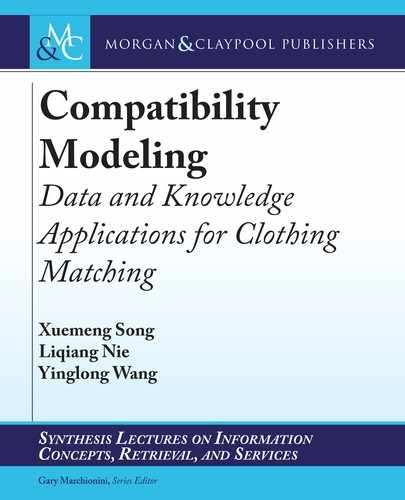
79
C H A P T E R 7
Personalized Capsule
Wardrobe Creation
7.1 INTRODUCTION
In Chapter 6, we introduced the personalized compatibility modeling between fashion items,
where the user preferences for items are exploited. In fact, apart from the user preference, the user
figure, like body shape, also plays an important role in the compatibility modeling. Meanwhile,
each outfit usually involves multiple fashion items, like the coat, top, bottom, and shoes, rather
than only two pieces. Toward this end, this chapter extends the scheme presented in Chapter 6
to handle the personalized compatibility modeling for outfits in the context of personalized
capsule wardrobe creation.
Capsule wardrobe (CW) is a minimum collection of garments (e.g., clothes and shoes),
with diverse combinations to inspire people to pair up various compatible outfits [41]. Appar-
ently, the capsule wardrobe plays a crucial role in people’s daily life by saving time and money
spent on dressing appropriately [63]. In practice, capsule wardrobes are usually created by fash-
ion experts through manually selecting garments and evaluating the potential outfits. To relieve
the burden of labor cost, recent researches in multimedia have generated reasonable CWs by
garment modeling (i.e., analyzing the garment-garment compatibility) based on the visual ap-
pearances and textual descriptions of fashion items [31, 41].
However, the CW generated by existing approaches may be unsuitable for individual users
because of their distinct demographics, preferences, body shapes, and consumption habits. For
example, the appearance of an outfit could largely depend on whether it is suitable for the user
body shape [38, 101]. erefore, lacking the modeling of the user body shape may result in inap-
propriate outfits for the target user. Moreover, apart from the garment compatibility, whether
an outfit is suitable also highly depends on the user preference [54]. As such, in addition to the
traditional garment modeling, we argue the necessity of user modeling (i.e., analyzing the user-
garment compatibility) to evaluate the potential outfits for the automatic CW creation. Fur-
thermore, pursuing the practical value, we propose the personalized capsule wardrobe (PCW)—a
collection of garments subject to creating both compatible and suitable outfits for the user.
Considering the existence of garments that have already been purchased by the user, to
be cost-friendly, we formulate the automatic PCW creation task as: given the original wardrobe
(i.e., a set of purchased garments) of a user, adding or deleting garments according to both
user-garment and garment-garment compatibilities. As illustrated in Figure 7.1, one purchased

80 7. PERSONALIZED CAPSULE WARDROBE CREATION
Original Wardrobe
Preference
Body Shape
Compatibility
Personalized Capsule Wardrobe
Figure 7.1: Illustration of the personalized capsule wardrobe (PCW) creation. Given the orig-
inal wardrobe of a user, a PCW is created by adding (green box) and deleting (red box) some
garments.
garment and four new garments are discarded and added to the original wardrobe, respectively,
to make the resulted PCW not only presents the higher garment-garment compatibility but also
caters to the user’s preference and body shape. In fact, this task confronts three key challenges:
(1) the PCW creation is a more complex combinatorial problem as compared to the conventional
CW creation, where the complex user profile derived from the original wardrobe should be taken
into account. erefore, how to adaptively build the PCW for different individuals is the major
challenge; (2) as both the outfit itself and the user profile (e.g., the preferences and body shapes)
determine the outfit compatibility for a given user, how to accurately evaluate the compatibility
of the potential outfit from both user-garment and garment-garment perspectives, poses another
challenge; and (3) most existing datasets only support either the user preference modeling or
user body shape modeling. Accordingly, the lack of dataset that facilitates the comprehensive
user modeling constitutes a crucial challenge.
To tackle the aforementioned challenges, we propose a combinatorial optimization-based
Personalized Capsule Wardrobe creation framework with Dual Compatibility modeling, named
PCW-DC. e key novelty of the proposed framework lies in the introduction of a scoring model
that can comprehensively evaluate the compatibility of potential outfits from both user-garment
and garment-garment perspectives. In particular, as illustrated in Figure 7.2, the scoring model
consists of two key components: user modeling and garment modeling. As for the user mod-
eling, we adopt the two most relevant aspects of the user profile: the user preference and body
..................Content has been hidden....................
You can't read the all page of ebook, please click here login for view all page.
